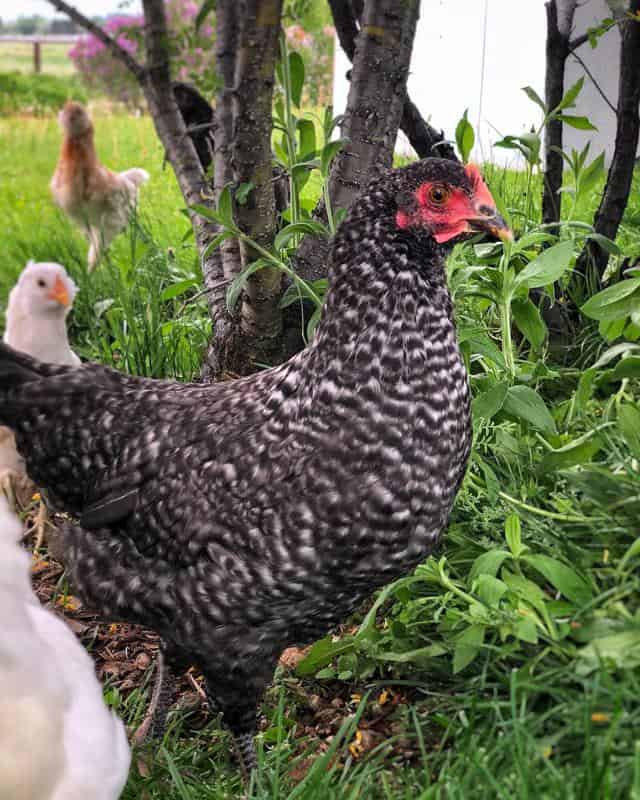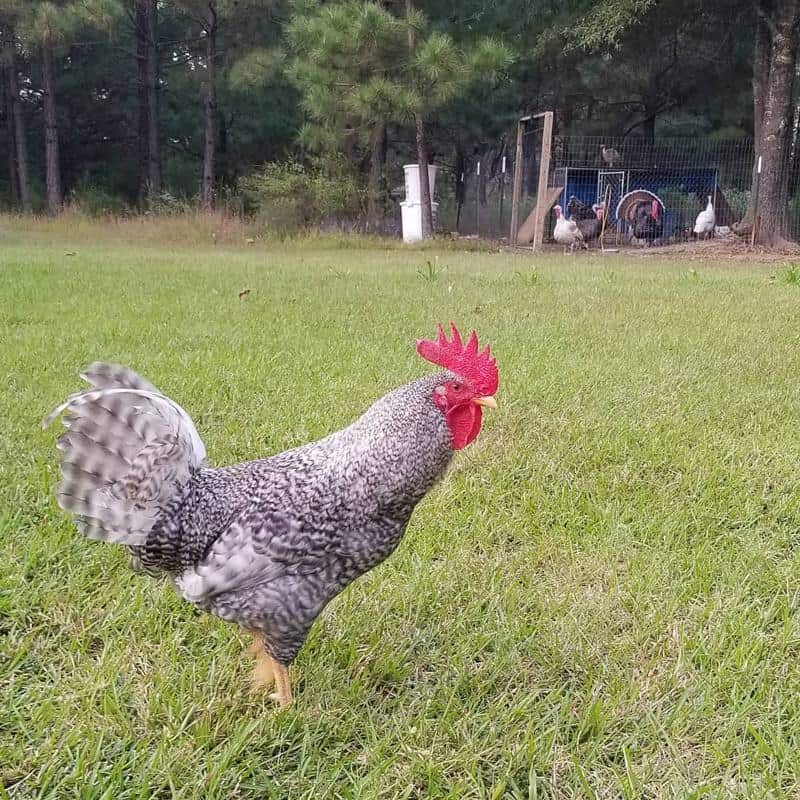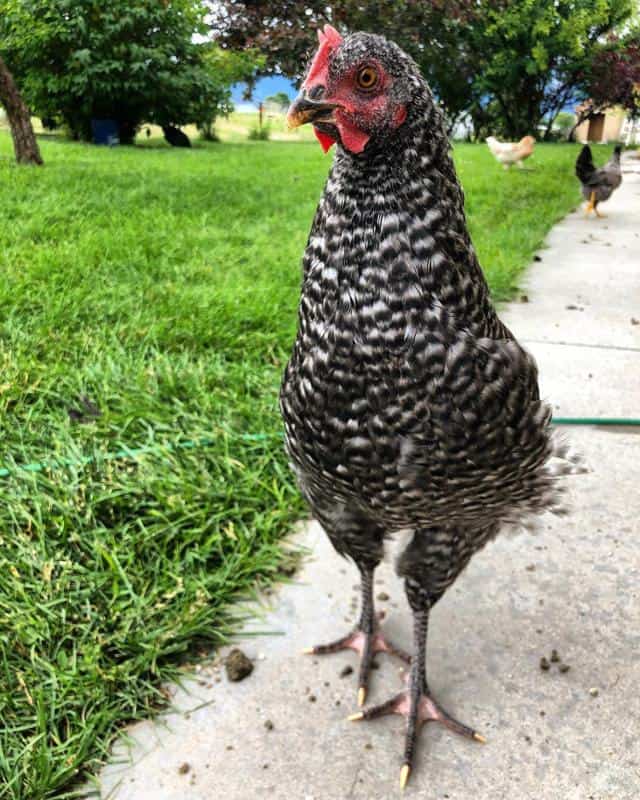The world of chickens is full of breeds with great potential that have been conspicuously overlooked over the years. The California Grey chicken is an excellent example of one such breed.
Despite having been around for more than 80 years, you’d be hard-pressed to find anyone who has had any significant experience raising these chickens. Even today, the California Grey is one of those chickens you’d consider yourself very lucky to find.

The production statistics of this chicken are quite impressive, and it can certainly serve more than one purpose on your farm. Even so, it seems to be mostly used for the breeding of a hybrid.
If you only had its name to go by, you may be fooled into thinking the California Grey chicken is grey in color. It’s certainly more interesting than that.
Thanks to recent interest, more farmers have been looking to add California Grey chickens to their flocks. Read on as we try to uncover the secrets of this rare chicken and understand why it deserves more attention than it has gotten.
California Grey Chicken Quick Facts:
| Names | California Grey, Production Black |
| Origin | Modesto, CA, USA |
| Purpose | Eggs and Meat |
| Egg Production/Year | 280 – 300 |
| Climate | Can withstand heat and cold but not extremes |
| Plumage Color | Grey and white barring; darker in females |
| Weight | 4.4 lbs. to 5.5 lbs. |
| Personality | Mild-mannered and quiet; not flighty |
| Unique Fact | Is not recognized by the APA despite being a true breed. |
The History of the California Grey Chicken
Development of the Breed
At some point in the 1930s, one Horace Dryden in Modesto set out to develop a chicken that could be used for meat but could also produce big white eggs. The California Grey was the result of his efforts.
The California Grey came about when Dryden bred the barred variety of Plymouth Rock chickens with White Leghorns.
- The Leghorn is an old breed that first made its way to the US in 1828. These birds were known as prolific layers, sometimes managing as many as 320 white eggs in a single year.
- The Plymouth Rock, on the other hand, is a multi-purpose breed that still manages to produce around 200 eggs in a year. It is mainly known for its use in the development of broilers, a purpose it continues to serve today.
These are the qualities Dryden wished to combine in the new chicken, and by all accounts, he succeeded in achieving this.
Horace or James Dryden
Some sources cite James Dryden, a former professor of poultry husbandry at the Oregon Agricultural College as the developer of California Grey Chicken.
James Dryden was heavily involved in the field of poultry development. He was, however, retired from the Oregon Agricultural College by the 1930s and would have been in his late 60s or early 70s by the time the California Grey was developed.
On the other hand, Horace Dryden is stated to be from Modesto, California in several chicken-related patent applications. This may create some confusion as to which Dryden was behind the creation of the California Grey.
It turns out we might have both Drydens to thank for this chicken. According to one source, the concept of the California Grey started with Professor James Dryden.
By 1913, James Dryden was already crossing Leghorns and barred rocks with great results.
Following his retirement, James Dryden moved to Modesto where his son Horace continued his work and succeeded in finally developing the breed that he named California Gray.
A Case of Poor Timing?
On paper, it seems like the California Grey would have been the ultimate backyard chicken. This makes its failure to make a significant impact in the poultry industry baffling.
One explanation that seems to make sense is that it was simply a case of poor timing.
Having been introduced to the public in the late 40s, the California Grey came at a time when production was moving away from backyard chickens. The focus was shifting to caged layers which favored smaller birds.
Physical Characteristics of California Grey Chickens

The California Grey chicken has barred plumage. The mature roosters have light gray and white barring while the mature hens have darker gray and white barring.
The barred variant of the California Grey is the only known variant of this breed. They have single combs that are red, as are their wattles and earlobes.
California Grey chickens are bigger than the Leghorns but typically smaller than the Barred Rocks. The male chickens will be 5.5 pounds on average while the females will be around 4.4 pounds when they mature.
Check out the two California Greys in the coop in this video.
The chicks hatch with down that is mostly black. There will be some white down on the chest wings, abdomen, and at the top of their heads.
The Production Potential of California Greys
Eggs
It is hard to oversell the egg-laying potential of California Greys considering it is a dual-purpose bird. The hens lay eggs at the rate of 280 to 300 eggs every year.
The hens start laying eggs at around the 20 to 24-week mark. They are said to maintain their high rate of egg-laying for multiple years before production starts to taper.
Meat
Thanks to its lineage, the California Grey chicken also makes a decent meat bird.
What should be noted is that the heaviest of these chickens only top out at around 5.5 pounds. This means you’ll be harvesting considerably less meat from every bird compared to a Plymouth Rock chicken.
Production of California White Hybrids
Although it is a rare bird, the California Grey chicken is actively used to produce its better-known counterpart, the California White chicken.
California White chickens are hybrids and don’t breed true. This means that a California Grey is always needed to produce a California White chicken.
Just like California Greys, California Whites are dual-purpose birds. However, the California Whites are even better layers as they are a cross of the California Grey and the White Leghorn.
It can be said that the popularity of California Whites plays an important role in the preservation of California Greys at this time.
Rearing California Grey Chickens

Housing and Environment
California Grey chickens are well-suited to being raised in a simple backyard. These chickens are hardy and don’t have any special housing requirements.
When setting things up for California Grey chickens, some of the factors you should consider are:
- This chicken breed is smaller than typical dual-purpose breeds. This means they can thrive on less space than something like the Plymouth Rock and other bigger breeds.
- California Grey chickens are hardy and stand up well to both heat and cold. However, measures should still be taken to protect them from weather extremes, especially if they have large combs.
- California Greys are not as interested in flying as Leghorns. This is great because it means they can be contained with a lower fence, unlike their Leghorn ancestors.
- Your coop should have enough nesting boxes depending on the number of California Grey hens you have. You may have multiple birds needing one at the same time.
- These birds are great for a free-range environment if you have space to spare. They can also tolerate a moderate level of confinement.
Diet
There is no secret to feeding the California Grey chicken. As a hardy chicken that was developed to do well when allowed to free range, what you feed your chicken will be ultimately determined by its purpose.
Despite being a dual-purpose breed, many farmers keep these chickens mainly as layers. They don’t yield as much meat when kept as broilers.
When feeding layers, you’ll have to take the following into account:
- Although these chickens are good at foraging, foraging alone is unlikely to give California Grey layers all the nutrients they need to sustain producing 280 to 300 eggs in a year.
- Commercial feeds are formulated to meet the increased demand placed on chickens today. Foraging chickens originally produced a lot fewer eggs than they do today.
- Additionally, commercial feeds also have the nutrients in the correct proportions. When only foraging, your chickens may end up with a nutrient imbalance depending on the food that is most easily available.
- It is okay to supplement your California Grey chickens’ feed with table scraps and grains, but moderation is important. Supplementary feeding can reduce your chicken’s appetite for more nutritious feed.
- Supplementary feeding should be done in the afternoon after your chickens have eaten the healthier feed.
- Chickens will eat more when it’s colder outside to help regulate their body temperature. Adjust the amount of feed provided accordingly.
- Give your chickens commercial feed that is consistent with their growth stage. The needs of a chicken when it starts to lay eggs are different from their needs in the weeks before.
Temperament
A lot has been said about the temperament of California Grey chickens and it’s almost all good. This chicken breed is said to have a calm and gentle temperament and is quite easy to handle.
These qualities make them easier to manage for beginners. These chickens are also quiet, which is great if you have neighbors who aren’t too thrilled with chicken noises.
Lifespan
The lifespan of these chickens is said to be in the range of six to ten years. This is normal for most chicken breeds.
Breeding and Brooding in California Grey Chickens
California Grey chickens are a true breed, not a hybrid. This is a common misconception because the similarly named and more common California White chickens are hybrids, not true breeds.
This means that the offspring of two California Grey chickens will be California Grey chickens as well.
However, if you’re looking to breed California Grey chickens, you will likely run into two challenges:
- These chickens are currently rare and finding one chicken, let alone a decent breeding pair, is a challenge.
- California Grey chickens rarely go broody, i.e., they are unlikely to sit on their eggs. Therefore, if you want to hatch the eggs, you’ll either need an incubator or another chicken breed that is more inclined to go broody.
APA (American Poultry Association) Status
The California Grey chicken has never received APA recognition as a true breed, and this has been cited as one reason why it continues to be rare today.
Also Read:
The Dilemma of California Grey Chickens
Almost anyone who reads about the California Grey will decide it’s an ideal bird to add to their farm. Unfortunately, as things stand, most people who read about these birds may never get the chance to buy them.
It’s difficult to state what contributed the most to this problem, but at the end of the day, California Grey chickens remain a breed that is difficult to come across.
As it is with rare chickens, there is a risk of some sellers passing off a different type of chicken as a California Grey. This is why it’s important to be familiar with the qualities of the bird you’re looking to get.
If you’re lucky enough to come across a California Grey chicken from a reliable seller, you shouldn’t hesitate to add one of these rare gems to your flock.
